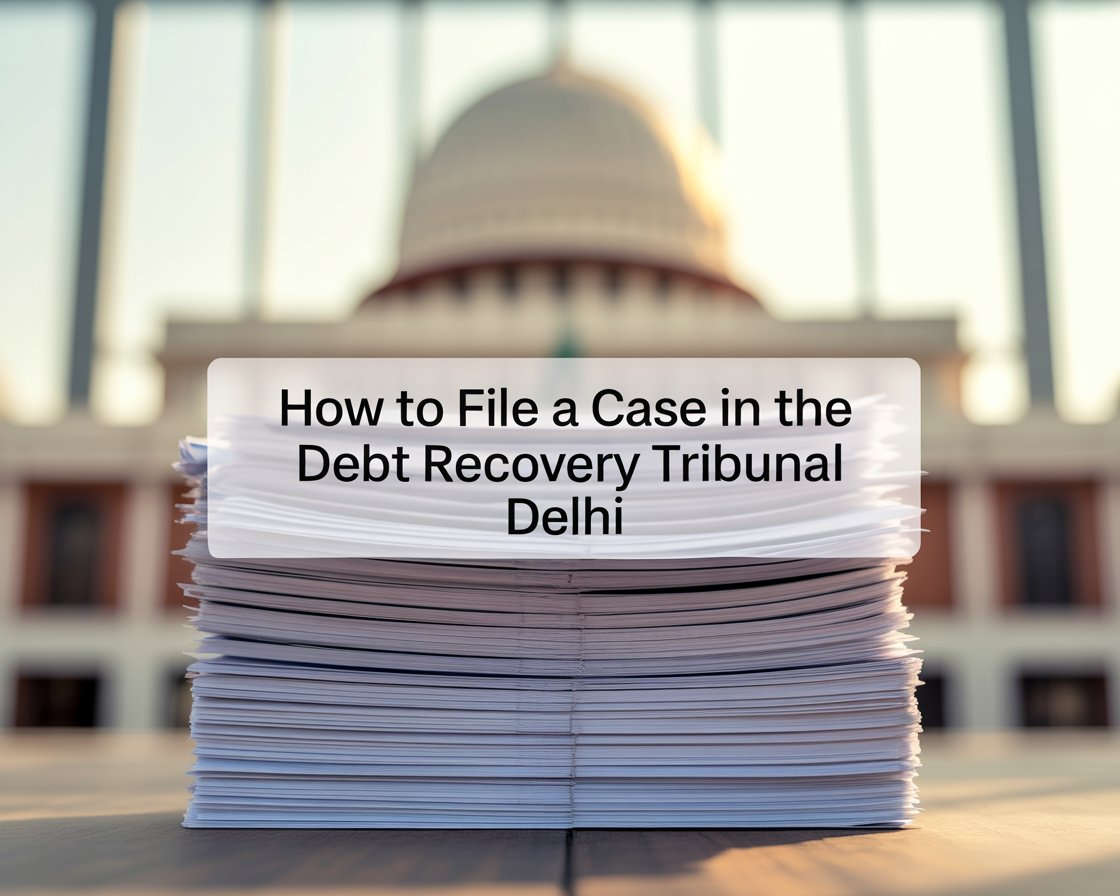Banks and other financial institutions often face difficulties when borrowers default on loans or fail to repay them. To simplify the debt recovery process, India established Debt Recovery Tribunals (DRTs), which provide a specialized legal mechanism for lenders to recover dues quickly. For companies and individuals in the capital, the Debt Recovery Tribunal Delhi has played a pivotal role in adjudicating such cases.
If you are wondering how to file a case in Debt Recovery Tribunal Delhi, this guide explains the entire process, including jurisdiction, required documents, and the right way to present your case.
Understanding the Role of Debt Recovery Tribunals
Under the Recovery of Debts and Bankruptcy Act, 1993 (RDB Act), Debt Recovery Tribunals were established to speed up the legal process of debt recovery. Unlike traditional civil courts, DRTs specialize in handling disputes related to debts owed to banks and financial institutions.
Key features of DRTs include:
- Jurisdiction over claims valued at ₹20 lakh and above.
- Fast-track operations and streamlined processes.
- Limited adjournments to prevent unnecessary delays.
- Right to appeal before the Debt Recovery Appellate Tribunal (DRAT).
The Debt Recovery Tribunal Delhi deals with cases within its territorial jurisdiction, ensuring both banks and borrowers have a clear legal structure to settle disputes.
Why File in the Debt Recovery Tribunal Delhi
Filing a case in DRT Delhi provides a dedicated platform for handling loan defaults and recovery disputes. Compared to conventional civil courts, which are often burdened with heavy caseloads, the DRT process is leaner, time-bound, and cost-focused.
For banks and financial institutions, this ensures faster settlement of disputes and quicker recovery of dues, improving cash flow and reducing non-performing assets. For borrowers, approaching DRT Delhi guarantees fair representation and the opportunity to present defenses under the debt recovery law, including provisions of the RDB Act.
In short, filing in the Debt Recovery Tribunal Delhi offers both creditors and debtors a specialized and efficient legal mechanism to resolve debt-related disputes.
Eligibility and Jurisdiction for Filing a Case
Before proceeding, ensure your case qualifies for filing in DRT Delhi:
- Monetary Limit: Only claims of ₹20 lakh or more are eligible.
- Parties Involved: Applications can be filed by banks and notified financial institutions. Borrowers cannot initiate cases but can defend themselves.
- Jurisdiction: Typically based on the borrower’s residence, place of business, or where the loan agreement was executed.
Once these requirements are met, the case can be filed in DRT Delhi.
Step-by-Step Guide: How to File a Case in the Debt Recovery Tribunal Delhi
Filing a case in the Debt Recovery Tribunal Delhi involves several structured steps:
- Drafting the Original Application (OA): Prepare the OA with borrower details, loan documentation, reasons for recovery, and the amount claimed (including principal, interest, and other charges).
- Compiling Documents: Gather loan agreements, sanction letters, collateral details, account statements showing default, and repayment notices.
- Filing the Application: Submit the OA and supporting documents to the Registrar of DRT Delhi in the required format along with applicable fees.
- Issuance of Summons: Once admitted, the tribunal issues a summons to the borrower, requiring them to respond within the given timeframe.
- Borrower’s Defense: The borrower may file objections, raise disputes on calculations, or highlight procedural errors.
- Hearing and Evidence: Both parties present evidence, oral submissions, and witnesses before the tribunal.
- Tribunal’s Order: Based on submissions, the tribunal passes an order, which may include possession of secured assets or appointment of a recovery officer.
- Execution of Order: The Recovery Officer executes the order, which may involve attachment of assets, garnishee proceedings, or sale of mortgaged property.
Documents Required for Filing in DRT Delhi
Applicants must have complete documentation to strengthen their case in DRT Delhi. Common documents include:
- Original loan agreements and related contracts.
- Demand notices sent to the borrower.
- Statements of outstanding dues.
- Mortgage or security deeds.
- Bank records showing defaults.
- Authorization letter for the officer filing on behalf of the bank.
Timelines and Efficiency in Debt Recovery Process
One of the biggest advantages of filing in the Debt Recovery Tribunal Delhi is time-bound proceedings. By law, cases should be resolved within six months. While borrower defenses or appeals may delay resolution, DRT cases still conclude far quicker than traditional civil suits.
Challenges in Filing a Case in DRT Delhi
Despite their efficiency, DRTs face some challenges:
- High caseloads leading to delays.
- Limited number of tribunals compared to rising NPA cases.
- Borrowers are using legal tactics to prolong hearings.
- Appeals before DRAT that extend timelines further.
Even with these hurdles, DRT Delhi remains faster and more specialized than civil courts.
Benefits of Filing in the Debt Recovery Tribunal Delhi
The benefits of approaching DRT Delhi include:
- Faster recovery timelines.
- Expertise in debt recovery law.
- Lower risk of unnecessary adjournments.
- Legally binding and enforceable orders.
- Cost-effective compared to lengthy civil suits.
Role of Lawyers in DRT Cases
Engaging experienced debt recovery legal services is crucial for success in DRT cases. Lawyers ensure proper drafting of applications, strategic presentation of evidence, and effective countering of borrower defenses. They also coordinate with banks and recovery officers to make the entire process smoother and more effective.
Conclusion
For banks and financial institutions, filing in the Debt Recovery Tribunal Delhi provides a structured and effective way to recover dues from defaulting borrowers. Understanding eligibility, documentation, and the step-by-step filing process helps lenders navigate the system with confidence.
While challenges like caseloads exist, the advantages of speed, specialization, and enforceability make DRT Delhi the right platform to recover debts. With proper preparation and expert legal support, institutions can safeguard their financial interests and achieve favorable outcomes.
FAQs
What is the jurisdiction of the Debt Recovery Tribunal, Delhi?
Debt Recovery Tribunal Delhi has jurisdiction over cases involving debts of ₹20 lakh or more, where the borrower or transaction falls within its territorial scope. It exclusively handles recovery claims filed by banks and financial institutions.
Who can file a case in DRT Delhi?
Only banks and notified financial institutions can initiate cases in DRT Delhi. Borrowers cannot file cases, but are entitled to defend themselves against claims.
What documents are needed to file a case in DRT Delhi?
Essential documents include loan agreements, sanction letters, mortgage deeds, repayment notices, bank statements, and proof of outstanding dues. These establish the lender’s claim.
How long does it take to resolve a case in DRT Delhi?
By law, cases should be resolved within six months. However, complexity, defenses, and appeals may extend timelines. Still, DRT proceedings are faster than civil courts.
Can a DRT order be appealed?
Yes. Orders from the Debt Recovery Tribunal Delhi can be appealed before the Debt Recovery Appellate Tribunal (DRAT). Appeals must usually be filed within 30 days, subject to pre-deposit requirements.








